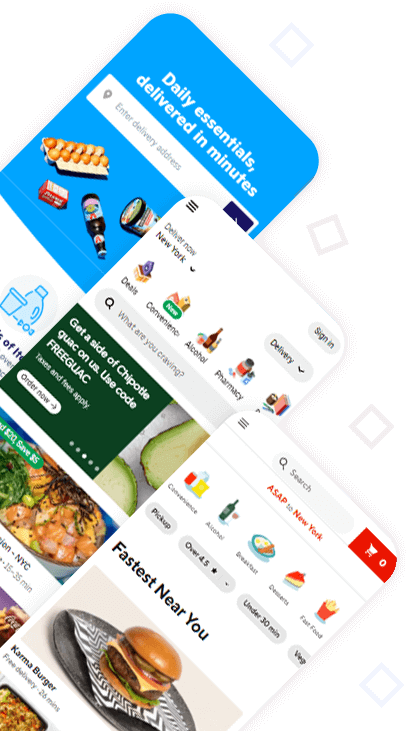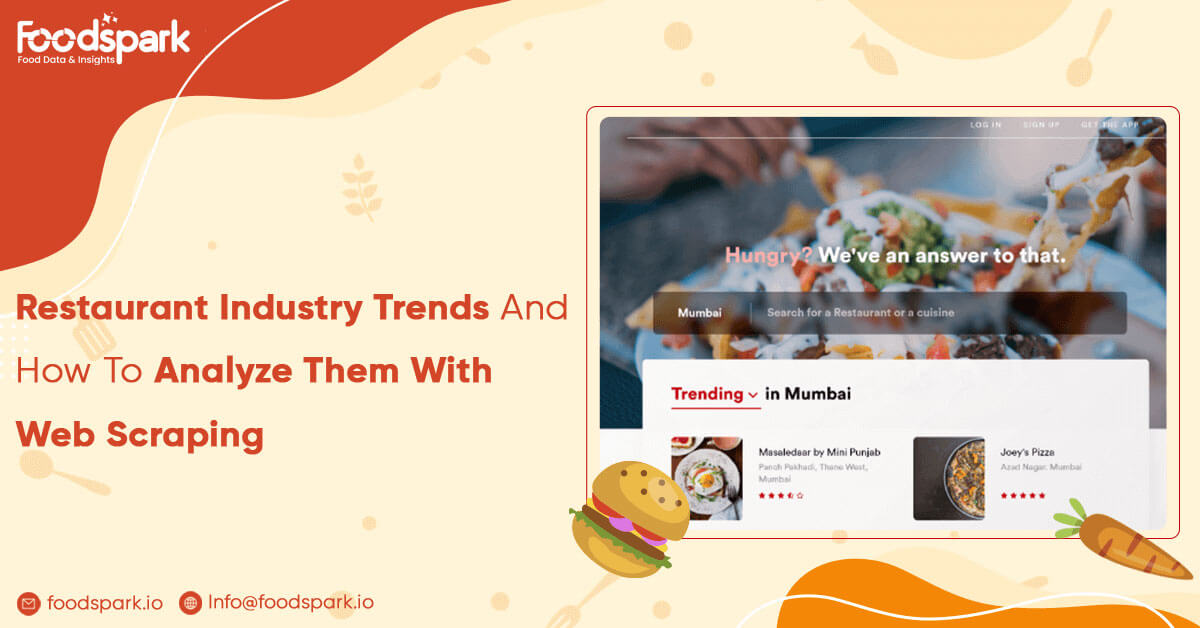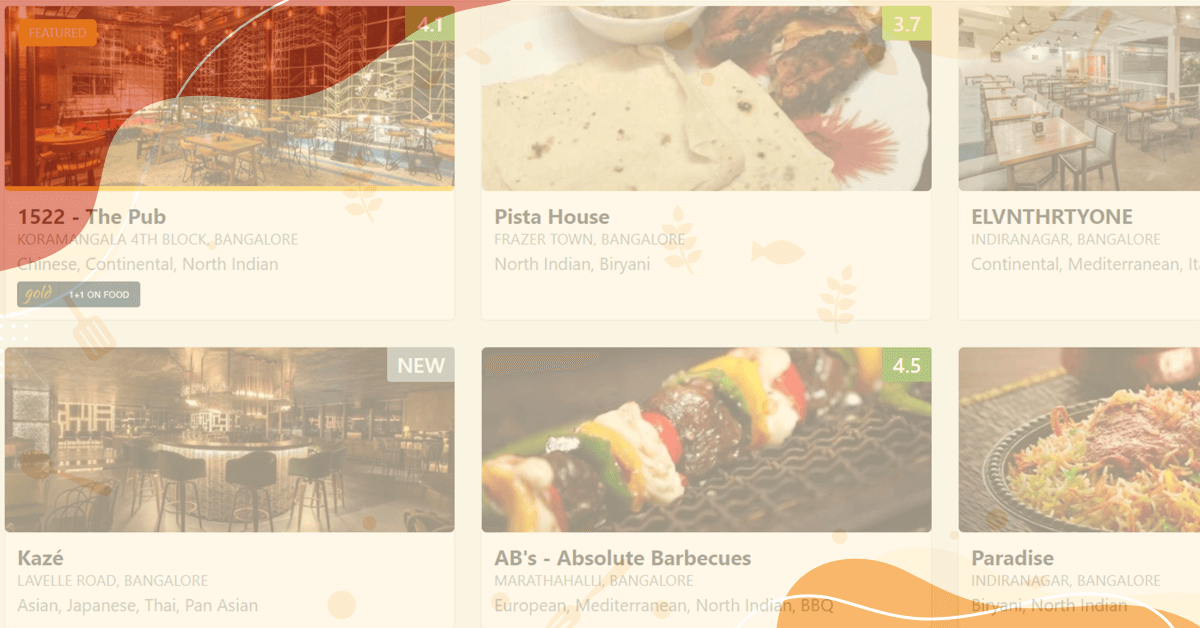Let's talk!
We'de love to hear what you are working on. Drop us a note here and we'll get back to you within 24 hours.

We'de love to hear what you are working on. Drop us a note here and we'll get back to you within 24 hours.

This is an article on restaurant industry trends that gives an in-depth and exciting analysis of the future of the restaurant industry using web scraping and data analysis software.
A recent boom in restaurants has led to a growing demand for food from these establishments, manifested as increased consumer spending on food.
Although there are economic theories that predict when global demand for a certain goodwill reaches its peak, there has yet to be a consensus on the future of the restaurant industry. The growth in international dining is unprecedented, but it comes with several caveats for restaurateurs due to increasing competition from new entrants into the market and more restaurants across all categories. You can go for Postmate restaurant data scraping, which will help obtain information from the restaurant industry.
When making plans for a new restaurant, consider what factors could affect its success. Being aware of the trends in the restaurant industry is paramount when considering these variables when starting up a new eatery.
These forecasts outline how rising costs and more competition could impact operators in future years, with restaurant-going being hit hardest by higher-than-anticipated food costs. This means that operating margins may be compressed. At some point, profits will become unsustainable, thus putting a strain on cash flow and increasing debt levels faster than anticipated.
In this restaurant industry trends article, we will use web scraping to examine the marketplace and try to understand what is happening. We will accomplish this by collecting data from various sources using Python and then analyzing the data.
Find companies doing well in the marketplace and get a feel for what’s driving them. All of their financial data will be available on a government website that we can scrape with Python, giving us a snapshot of their business and how they did in terms of sales.
Find companies that are having trouble in the marketplace and get a feel for what is happening with them. The financial data will be available on a government website, and we can scrape this information to give us an idea of their business.
One thing that can help is understanding how the restaurant industry is doing and using this to forecast future sales. When analyzing financial data, let’s look at the trends in the overall numbers versus those of specific industries, such as restaurants vs. fast food restaurants.
When analyzing the financial data, let’s look for increases in our competitors’ sales and set up alerts as this increase occurs. Then, when our competitor starts to see their numbers drop, we can set up another alert to get ahead of the curve. It will allow us to catch the trend change from our competitors and be ready when it happens.
The benefits of web scraping restaurant data for your business are numerous. It gives you a better idea of when your competitor’s sales may be beginning to drop, and it also allows you to figure out how much of an impact that will have on their bottom line. It gives you a more realistic idea of their actual revenues and their potential return on their investments.
One of the best uses of web scraping restaurant data is to create a sales forecast. By having a better handle on what sort of sales are being generated and how they are being developed, you can use this information to figure out how much money you need to make to turn a profit.
Let’s say you want something that will give you an idea of what’s going on in your industry and where the changes are happening for your competitors. By analyzing financial data, we can see trends in our customers and decide how we will adjust our strategies moving forward.
Every company wants to know when to react to a change in trends, and the best way to do that is to create an action plan. The action plan will give you a jump start on catching the changes in your industry before they make a complete dent in your finances.
Once you have your competitor’s financial data, it’s time to research how their company runs, primarily how they deal with business downturns or boom times. Any time a business goes through a period of change, and there’s less or more revenue than expected, people interested in using web scraping restaurant data will want to know if it’s because it’s not as profitable as they thought or if something went wrong.
Look at your competitors’ strengths, such as their experience running the business, their advertising, their location strategy, and how they market themselves. Once you have done this, you should identify the areas where you can use this information to your advantage. In addition, you should identify where you could improve, such as the skills and abilities of your sales staff and management team.
To create an action plan to help your business, get together with a list of marketing initiatives you have started in the past few years and their impact on your bottom line. In addition, get together with the people working under you and talk about how they could improve their work performance and bridge communication gaps between them.
Once you have identified the areas that need improvement, it’s time to make a strategy on how to use web scraping restaurant data to help you reach your goals. Determine what changes will help you improve the business and attract new customers. Once this plan is completed, determine how long it takes to implement it to be effective. In addition, test out the plan by implementing it with new employees and ensuring they can hit their goals.
Once this analysis is complete, you can use this information to think about what sorts of strategies will work best for them to help them continue having a good business in the long run. You can also use web-scraped financial data to understand which areas your competitors are expanding into and try and take some tracks there yourself.

First, we will need to choose a scraping engine compatible with restaurant data and able to run scripts. Then, we will load the script into the scraping engine and connect it to a proxy. The engine passes all requests through the proxy, funneling the scraped data into a database.
Since most restaurant websites do not have APIs, web scraping is one of the best ways to get restaurant data for analysis. The downside is that each website has slightly different information on its pages and what can be scraped from them, so there is no single way to scrape all this information.
Scraping restaurant data is also unique for each restaurant and website. However, there are a few common steps to this process:
Many scraping engines are available on the Internet, and every web scraper uses them to collect data from websites and extract it according to their requirements. They are all designed to collect data from websites and then store it in a database so that they can process it further.
If you want to scrape restaurant and food industry data, the best website scraper is Foodspark.io. It’s compatible with different restaurant websites, forms a unique database based on the website you are scraping, and provides advanced analytics. You can use it to get various restaurant data like customer reviews, menu pricing, and other information.
Using web scraping restaurant data, you can mine valuable information that you can use to make effective and profitable business decisions. Several online platforms help us look at the metrics of restaurants and how they perform throughout the day. In addition, we can also analyze their financial data, which will give you a good idea of how profitable a restaurant is and where they are losing money.
January 21, 2025 B2B marketplaces use data collection to expand and maintain relevance in the food industry. Organizations can improve...
Read moreJanuary 2, 2025 Web scraping has now become an important strategy in the accelerating world of e-commerce, especially for businesses...
Read more